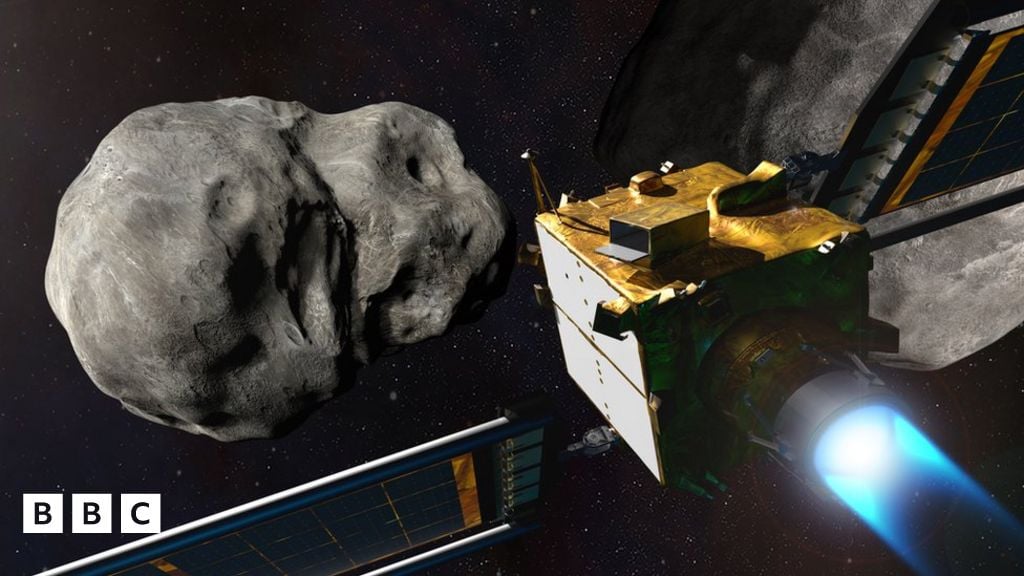- cross-posted to:
- space@lemmy.world
- cross-posted to:
- space@lemmy.world
Asteroid behaving unexpectedly after Nasa’s deliberate Dart crash::A school teacher and his students have discovered that an asteroid deliberately hit by a Nasa spacecraft is behaving in a weird way.
…heard on the TV in the background while the main character is leaving the house.
Man, there is a xkcd for everything …
One of their neighbours has to be erratically throwing their family and stuff into the car, awkwardly saying hey to the main character as they jump in their car and speed off.
Looks like the crew of the Rocinante has another mission on their hands.
Aw shit, the Mormons are gonna lose their gigantic space chruch!
Directing asteroid by launching everything mormon at it? Let’s make this scifi a reality.
^I’d also add actual mormons as munitions.^
Lol, no, I was referring to a plot point from The Expanse where some of the main characters stole a massive spaceship they built from the Mormons to ram into a massive asteroid in order to move it out of a collision course.
Seriously, I’m so glad to be out.
The summary bot didn’t even list the odd behavior. It has continued to decelerate a month after impact. Find that a bit unusual and counterintuitive to newton’s laws. But I’m not a physicist.
It’s slowing down to look for the fucker that sucker punched him lol
It was an alien ship with camouflage and they ain’t happy.
Somewhere a dev in the real world is scrambling to fix the bug in the simulation’s physics engine.
I guess they broke their engine! /s
So did NASA not track the asteroid for the last year? Like they just crash a rocket into it and call it good right away? No follow up or deeper analysis? You’d think they would want to monitor it for any weird or unexpected behavior but instead they find out from a high school teacher?
People still think
tachyonsneutrinos move faster than light because a professional laboratory gathered data incorrectly one time… I’m not saying these high schoolers messed up their data collection, but it seems more likely than them discovering a new physical phenomenonBut tachyons are by definitions just “hypothetical particles moving faster than light”. Meaning if they exist, of course they move faster than light. I don’t know which lab your talking about, but people are absolutely right to think that tachyons are faster than light (if they believe tachyons to exist, which of course never has been proven).
Maybe you have the wrong word here and that people think that neutrinos can move faster than light, since there was a false measurement in CERN? But that one has been reported and updated already.
Fun fact: particles that move slower than light (i.e. all known particles with mass) are called tardyons.
Wow, TIL
The teams behind the DART mission are tracking it, and will continue to track it into the future. There is even a new mission set to launch to send another craft to the asteroid to gather more information. So, yeah lots of follow up to come over the next year. It is just far more likely that they don’t really have much to say ATM aside from well, that is not acting as predicted, we need more evidence/data to figure out what exactly is going on. Which is what this students paper basically concluded.
https://phys.org/news/2023-09-dart-impact.html gives a far better overview of the situation than the BBC article linked above.
NASA is run by the federal government. It would make sense that they wouldn’t report something like that, at least at this time, in order to avoid an overreaction by the public.
This is one of the more fascinating space stories. The modeling for such an object should be (relatively speaking), rather simple. Something isn’t going to speed up or slow down without a force being applied to it. So NASA should be able to model this quite accurately.
Guessing it’s not perfectly simple because the splatter, dust, heat energy released, oblique angle of impact, etc.
Space Balls colliding are a bit trickier than clacker balls.
{edited to get to say Space Balls}
Should be relatively simple to work backwards and figure out new stuff that wasn’t accounted for, though maybe not with 100% accuracy.
You would think that NASA has an ongoing project monitoring it after spending millions crashing a spaceship into it. Not sure why we’re hearing this from some high school students.
They are still watching it. https://phys.org/news/2023-09-dart-impact.html gives much better details on this situation including:
The DART science team is continuing to analyze their data, as well as new information on the composition of the asteroid moonlet and the characteristics of the ejecta to learn just how much DART’s initial hit moved the asteroid, and how much came from the recoil.
But now another group of researchers, led by Taylor Gudebski and Elisabeth Heldridge, used the 0.7m telescope at the Thacher Observatory located on the campus of The Thacher School in Ventura County, California to make their observations.
They quite likely already know of this and just have not reported any findings yet, likely as they want to collect more data first and have another launch planned to study this further:
Additionally, another spacecraft will launch in 2024 to study Dimorphos even closer. ESA’s Hera mission should arrive at Didymos and Dimorphos in December 2026. Hera will undertake a detailed study of Dimorphos to understand more deeply how the impact affected it.
Just so happens these students published their work first. That does not mean the team behind DART are not monitoring it any more and have nothing further to report or have moved on to other work. Even if that is what the OP article seems be be hinting at.
smaller pieces which fell off are hard to track while their effect on the trajectory might still be substantial. Small change to the orbit early on makes a big difference after a while.
Bah, what are we paying those nerds for anyway? Just math it out!
This is the best summary I could come up with:
However, a teacher and his class studying the rock have now discovered that since the collision, it has moved in a strange and unexpected way.
By crashing into the smaller asteroid, the Dart mission successfully altered Dimorphos’ orbit by “tens of metres”.
Dart, which stands for Double Asteroid Redirection Test, used a spacecraft around the size of a fridge.
By successfully crashing directly into Dimorphos, Nasa was testing if it could use similar methods to knock an asteroid off course, if one is in danger of hitting the Earth.
After discovering the unusual behaviour of Dimorphos, it’s likely that Nasa will have to factor in the high school’s findings, if they ever launch another asteroid redirection mission in the future.
The European Space Agency is launching a mission called Hera, which will arrive at Dimorphos in 2026 and could reveal more details as to what happened to the asteroid following the impact.
The original article contains 360 words, the summary contains 152 words. Saved 58%. I’m a bot and I’m open source!
We woke it up
To be fair, it’s like playing billiards with a rope for a cue, in 3 dimensions, in zero gravity, with rocks for balls, and a coke can for the white, and the balls are moving.
I’m surprised they even hit it, give them a few years before you start expecting them to do trickshots.
They say, the dart was about the size of a fridge. It started in Nov 2021 and finished in Sep 2022. About a year later.
I say, there was still a pizza in the fridge.
Because, when you eat a year old pizza, it can slow you down a little, afterwards…
deleted by creator
deleted by creator











